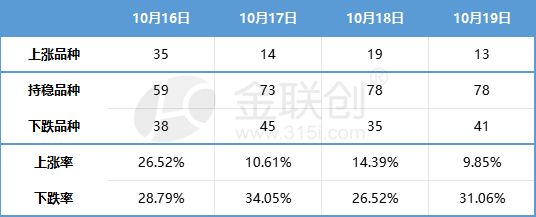Recently, the tense situation of the Israeli-Palestinian conflict has made it possible for the war to escalate, which has to some extent affected the fluctuation of international oil prices, keeping them at a high level. In this context, the domestic chemical market has also been hit by both high upstream energy prices and weak downstream demand, and the overall market performance remains weak. However, macro data from September showed that the market situation was improving marginally, which deviated from the recent sluggish performance of the chemical market. Under the influence of geopolitical tensions, international crude oil continues to fluctuate strongly, and from a cost perspective, there is support at the bottom of the chemical market; However, from a fundamental perspective, the demand for gold, silver, and other commodities has not yet erupted, and it is an undeniable fact that they will continue to weaken. Therefore, it is expected that the chemical market will continue its downward trend in the near future.
The chemical market remains sluggish
Last week, domestic chemical spot prices continued to perform weakly. According to the 132 chemical products monitored by Jinlianchuang, the domestic spot prices are as follows:
Data source: Jin Lianchuang
The marginal improvement of macro data in September deviates from the recent downturn in chemical industry
The National Bureau of Statistics released economic data for the third quarter and September. Data shows that the consumer goods retail market continues to rebound, industrial production activities remain stable, and data related to real estate also shows signs of marginal improvement. However, despite some improvements, the extent of improvement is still limited, especially the significant decrease in real estate investment, which makes real estate still a drag on the domestic economy.
From the data of the third quarter, GDP grew by 4.9% year-on-year, better than market expectations. This growth is mainly driven by a significant increase in the driving force of consumption. However, the four-year compound growth rate (4.7%) in the third quarter is still lower than the 4.9% in the first quarter. In addition, although the GDP deflator slightly improved from -1.5% in the second quarter to -1.4% year-on-year, it remains negative. These data all indicate that the economy still needs further repair.
The economic recovery in September was mainly driven by external demand and consumption, but investment was still negatively affected by real estate. The production end of September has recovered compared to August, with industrial added value and service industry production index increasing by 4.5% and 6.9% respectively year-on-year, which is basically the same as August. However, the four-year compound growth rate increased by 0.3 and 0.4 percentage points respectively compared to August. From the changes in demand in September, the economic recovery is mainly driven by external demand and consumption. The four-year compound growth rate of social zero and exports has further improved compared to August. However, the decline in the compound growth rate of fixed assets investment is still mainly affected by the negative impact of real estate.
From the perspective of the main downstream fields of chemical engineering:
In the real estate sector, the year-on-year decline in new home sales in September only slightly improved. In order to promote policy development on both supply and demand sides, further efforts are needed. Although real estate investment is still weak, new construction shows a phased improvement trend, while completion continues to maintain prosperity.
In the automotive industry, “Jinjiu” retail continues the trend of positive growth on a month on month basis. Due to the increasing demand for holiday travel and the promotion activities at the end of the quarter, although retail sales reached a historic high in August, retail sales of passenger cars in September continued the trend of positive growth on a month on month basis, reaching 2.018 million units. This indicates that terminal demand is still stable and improving.
In the field of household appliances, domestic demand remains stable. According to data from the Bureau of Statistics, the total retail sales of consumer goods in September were 3982.6 billion yuan, an increase of 5.5% year-on-year. Among them, the total retail sales of household appliances and audiovisual equipment were 67.3 billion yuan, a year-on-year decrease of 2.3%. However, the total retail sales of consumer goods from January to September were 34210.7 billion yuan, a year-on-year increase of 6.8%. Among them, the total retail sales of household appliances and audiovisual equipment were 634.5 billion yuan, a year-on-year decrease of 0.6%.
It is worth noting that the marginal improvement in September’s macro data deviates from the recent sluggish trend in chemical industry. Although the data is improving, the industry’s confidence in demand for the fourth quarter is still relatively insufficient, and the policy gap in October also makes the industry hold a reserved attitude towards policy support for the fourth quarter.
There is support at the bottom, and the chemical market continues to retreat under weak demand
The Palestinian-Israeli conflict has sparked five small-scale wars in the Middle East, and it is expected to be difficult to find a solution in the short term. Against this backdrop, the escalation of the situation in the Middle East has led to strong fluctuations in the international crude oil market. From a cost perspective, the chemical market has thus gained some bottom support. However, from a fundamental perspective, although it is currently the traditional peak season for gold, silver, and ten demand, demand has not exploded as expected, but has continued to be weak, which is an undeniable fact. Therefore, it is expected that the chemical market may continue its downward trend in the near future. However, the market performance of specific products may vary, especially products that are closely related to crude oil may continue to have a stronger trend.
Post time: Oct-23-2023





